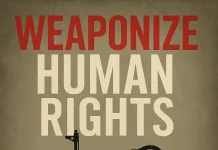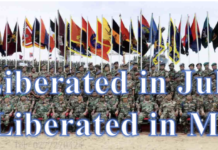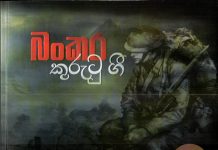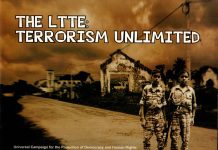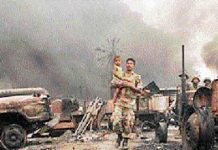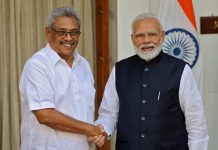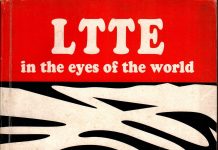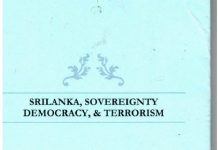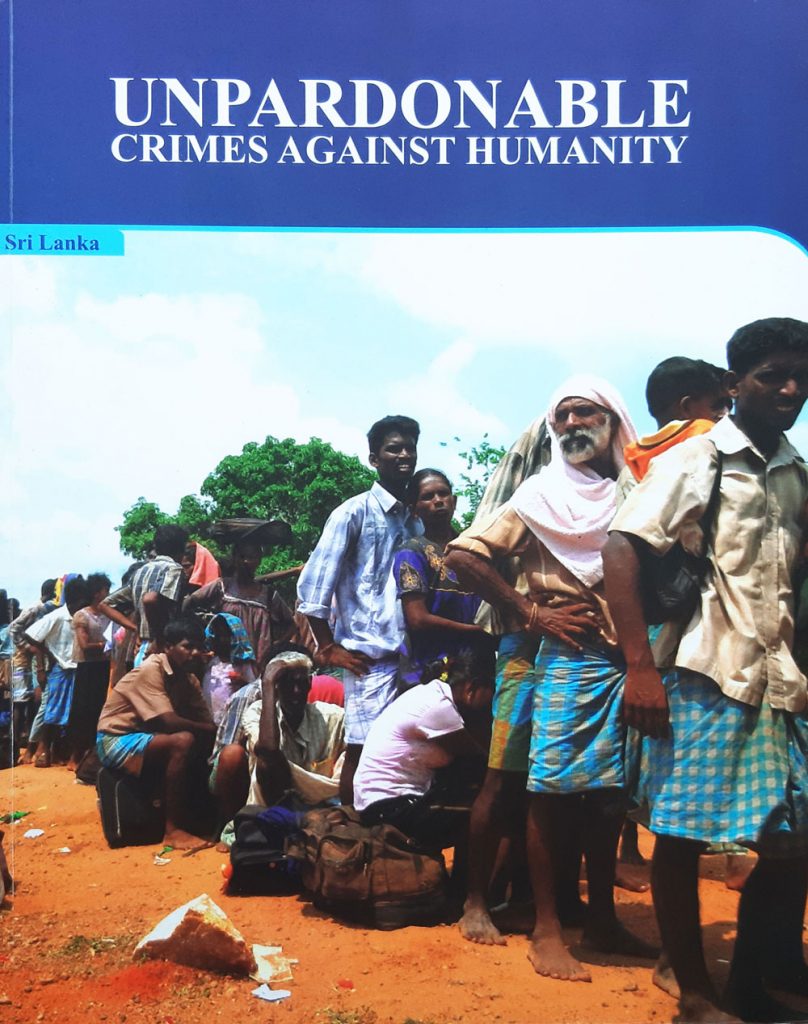

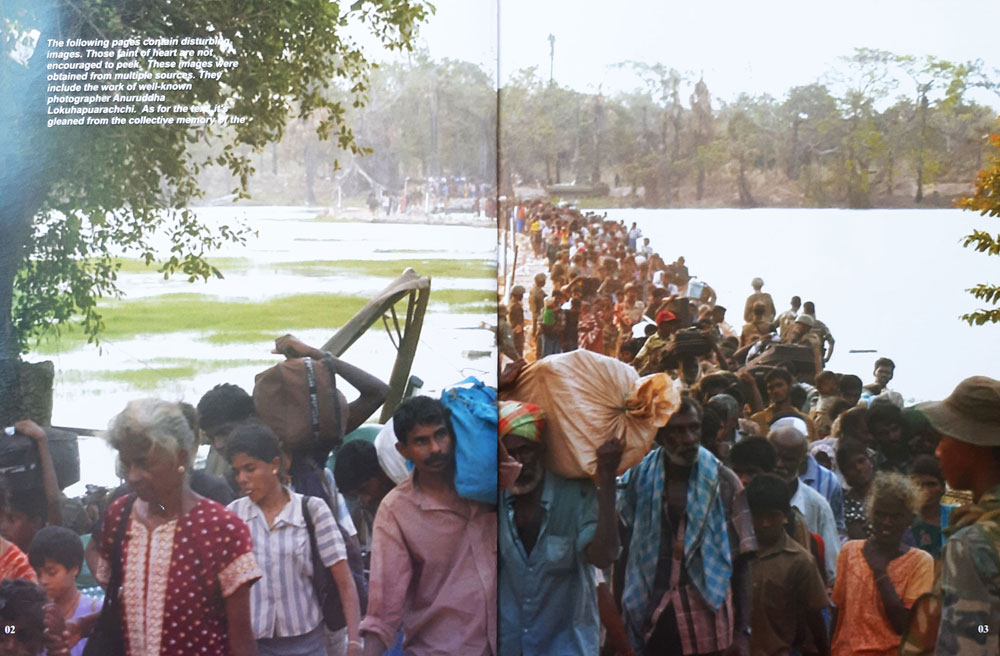
PREAMBLE
The government and people of Sri Lanka prevailed fought and prevailed against the world’s most ruthless terrorist outfit, the Liberation Tigers of Tamil Eelam (LITE). It was a war no one wanted, not even those who the LTTE and other militant Tamil groups and their political mouthpieces sought to liberate for no one except the deranged and fanatical and those spurred by the highest virtues of sacrificing all for the benefit of fellow creature would happily embrace death, dismemberment and other war-wrought deprivations.
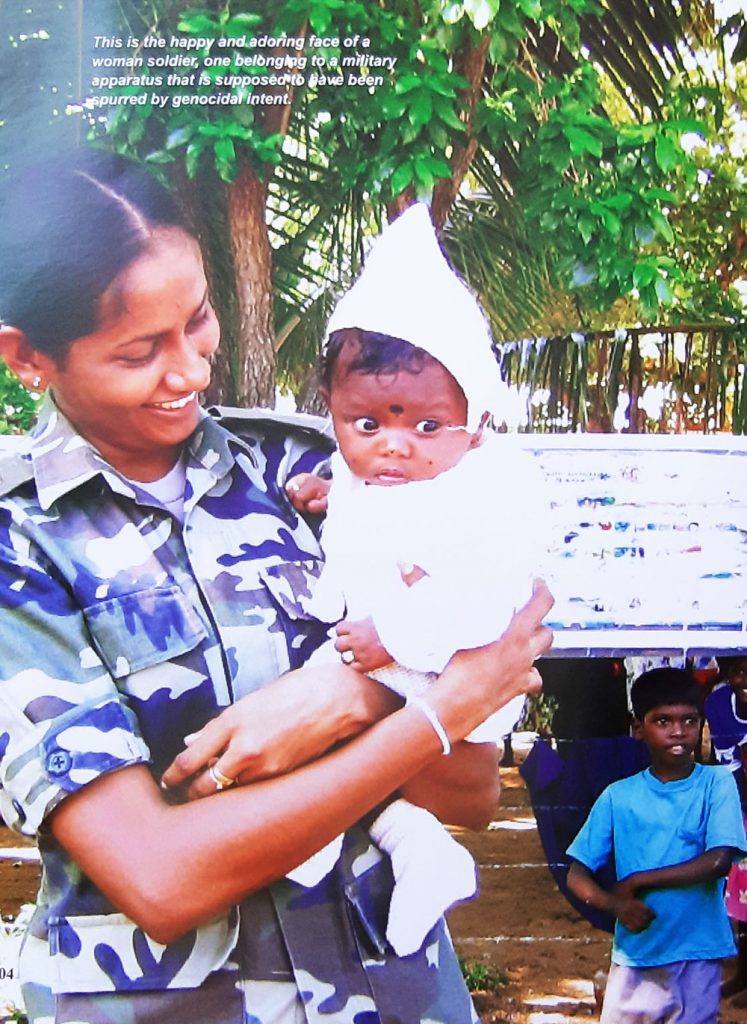
All wars end, sooner or later, and so did this, after three long, bloody and fear-terror filled decades. In the final months of the war, close to 295,000 civilians held hostage by the LTTE rescued by the Sri Lankan security forces formally registered at the centres set up to receive them. This, out of a total of approximately 300,000 people estimated to be living in the territories liberated. Over 4000 LTTE cadres had perished according to the last LTTE communication intercepted by the security forces. Hundreds of other combatants would have been killed thereafter. Hundreds fled to other parts of the country and to India without registering. Close to a thousand were killed by the LTTE as they attempted to flee. Over 4000
troops died in the process.
Through all these terrible times, the Government of Sri Lanka spared no pains to ensure that food, medicine and other supplies got through to the civilians held hostage by the LTTE, even though it was an established fact that the LTTE pilfered at will. The Government used the good oflices of the World Food Program, the World Health Organization and other charitable multilateral organization and international NGOs to secure enough supplies and the ICRC to ensure that whatever was necessary was delivered.

Throughout the three decades of the conflict, successive governments continued to pay the salaries of state sector employees, including doctors, teachers, midwives, nurses, attendants and other personnel, serving in LTTE-held areas even though it was well known that they willingly or unwillingly acted according to LITE dictate. It is well known that there was never scarcity, even in those unhappy times and unhappy places.
In September 2006, the Government of Sri Lanka established a consultative apex body to provide humanitarian assistance to the conflict affected populations in a co-ordinated manner. This was in response to a request made by the ‘Co-Chairs to the Peace Process’ (made of representatives from the USA, Japan, Norway and the European Union), and designed to complement in a more systematic manner the regular humanitarian efforts of the state under trying and forbidding conditions. This body,
known as CCHA (Consultative Committee on Humanitarian Assistance), was made up of the Co-Chairs, the Minister of Disaster Management and Human Rights, the Senior Advisor to the president, Secretary of the Ministry’ of Defence and other secretaries of relevant line ministries including those pertaining to the subjects of health and education, the Commissioner General of Essential Services, the Government Agents serving in these areas, all heads of UN agencies, heads of ICRC, ECHO and the Consonium of Humanitarian Agencies and representatives of the security forces and the Police.
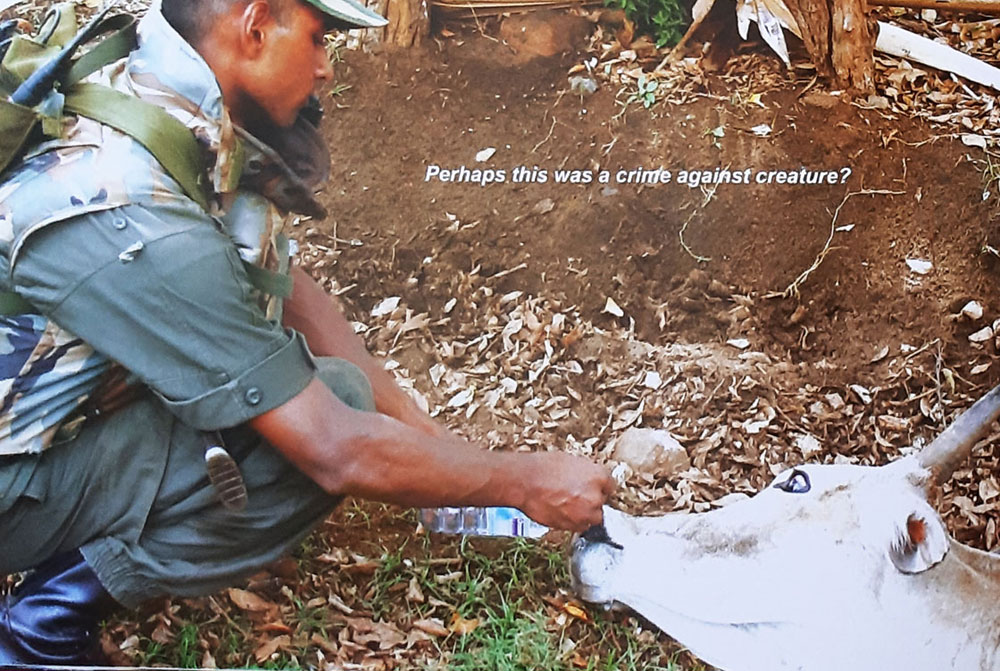
This committee met regularly, formulated policies, revised them as and when necessary and helped ensure that the needful got done with respect to an adequate and consistent flow of supplies to these areas. Supplies were sent to IDPs under the World Food Program, essential items were also supplied to those displaced prior to 2005. Multi Purpose Cooperative Societies were also provided with adequate quantities of supplies to be distributed commercially. Quantities were decided through consultation
between the World Food Programme, the Ministries of National Building and Resettlement and the respective Government Agents. The Regional Directors of Health Services were consulted regarding quantities of
medical supplies and requests for additional supplies always responded to positively.
A special logistical hub was set up in Vavuniya with support from the WFP and UN agencies to facilitate the storage of nearly 5000 MT of food and non-food items in order to accelerate supplies to the un-cleared areas and distribution thereafter. Shortfalls and bottlenecks were brought to the notice of all relevant authorities and prompt action was taken to remedy the situation. All this is recorded and acknowledged by the multilateral agencies facilitating operations and providing supplies. It must be noted that even as the retreating terrorists dragged with them the civilian
population for human-shield purposes, these stocks were also relocated so that access remained and people did not starve, even though the LTTE, as always, pinched the larger share for cadre comfort. Indeed excess stocks of rice were found in warehouses in Mullaitivu at the concl usion o frescue operations.
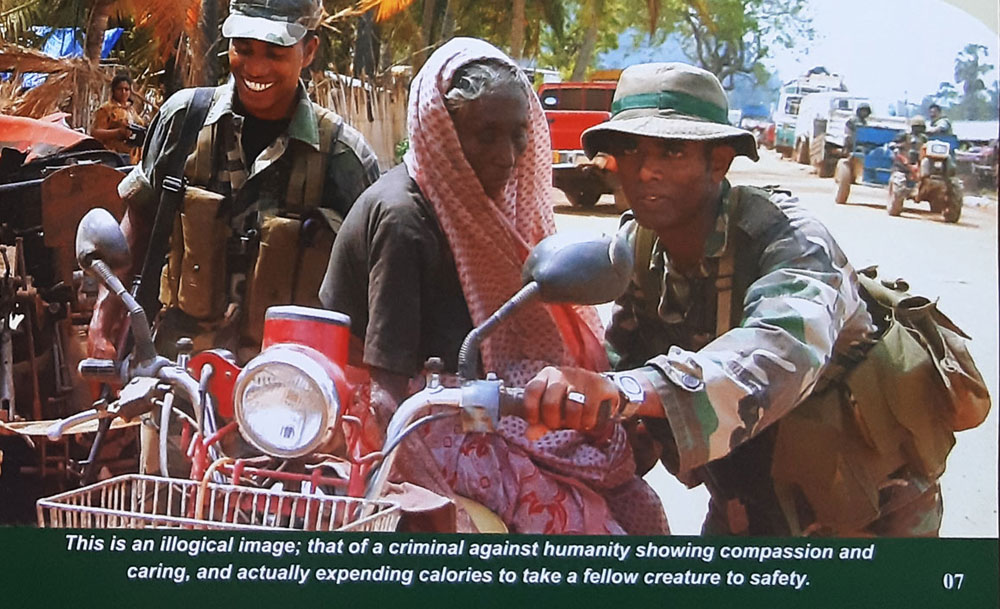
What genocidal entity would in its right mind go out of its way to service thus a population marked for slaughter? Wouldn’t it be crazy for them to ensure that there was always a minimum of a 3-month buffer stock of supplies in these areas right until the end of the conflict?
In the early months of the year 2009, with end of conflict in sight, the Government took steps to deal effectively with the envisaged and formidable IDP situation. Over 290,000 people fled into Government held areas. They had to be protected and taken care of. No government with genocidal intent would go to this extent to provide for a group of people they intended to harm. It would have been cheaper to massacre
them all for those who engage in genocide have already absolved themselves of guilt and anyway, you can only be hanged once whether
you kill one or one hundred thousand. But this government was prepared to receive close to three hundred thousand hostages once they were
freed from their long years of misery’ at the hands of the LTTE. They were fed and clothed: their illnesses checked by doctors and prescribed medicines provided. They were reunited with their families. The children, who would otherwise have been forcibly tuned into child-combatants, recovered their childhood and the opportunity to pursue education.
No government with genocidal intent would not only secure the release of close to three hundred thousand intended victims, many if not the vast majority who could reasonably be suspected to have supported the LTTE one way or another, but go on to care for them, see to their health needs. education and other matters in ways that few displaced people anywhere on earth have been treated. Neither would a genocidal government treat captured or surrendered combatants (of a brutal terrorist organization with as horrendous a track record as has the LTTE) with cordiality and respect. They were not only fed and clothed, but their health and psychological needs were also taken care of. They were given skills so they could be gainfully employed. Those of school going age were accorded the necessary facilities to sit for examinations. More than 500 child combatants
were duly reunited with their parents.
If genocide was intended, the government would not have risked the lives of a single soldier. Over 4000 perished in the operation to rid the country of terrorism and to free close to 300,000 fraternal citizens. That’s hardly
efficient in the matter of perpetrating genocide.
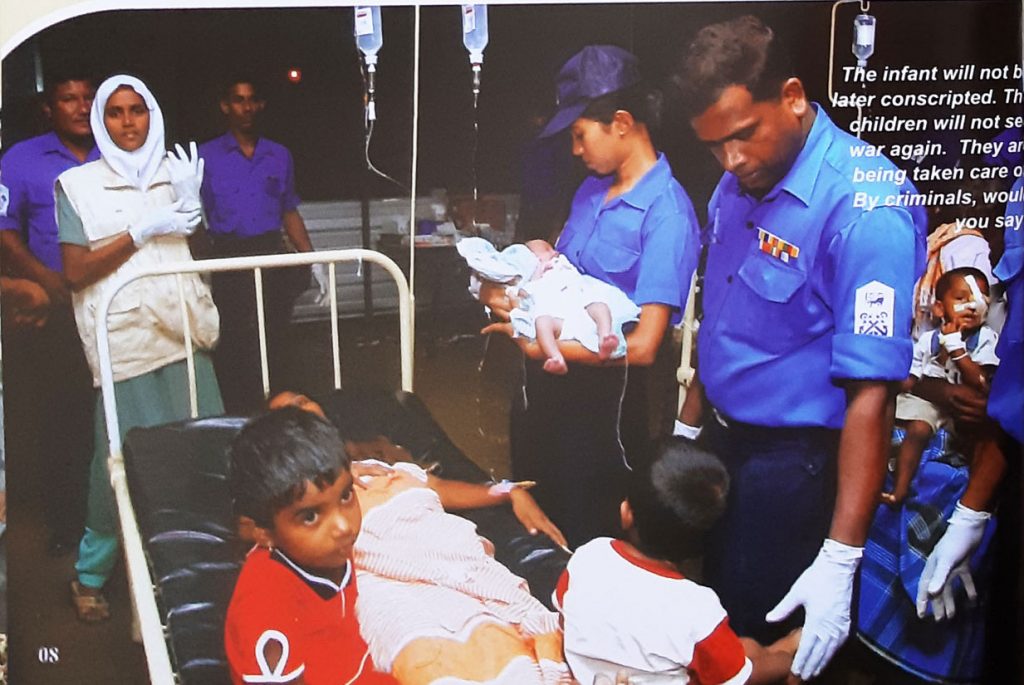
Why should a government intent on an at-any- cost military offensive bother to send food and medicines to conflict-ridden areas? Why pay
salaries to those intended for genocidal guillotine? Why risk life and limb to help pregnant women, the sick, the elderly, infants and children? Would it not have been more cost-effective in a genocidal calculus to kill them all? After all, as Hitler said, who would decades later talk of the massacre of the
Armenians?
The truth is that right up to May 15, 2009, there was enough food and medicine for the populace. In addition to the supplies sent to these areas,
there were successive bumper harvests of rice which was more than ample to feed the hungry, even after the LTTE exacted portions by way of
coerced taxation and outright pilfering of supplies. Why feed those you plan to kill anyway? Does not make sense.
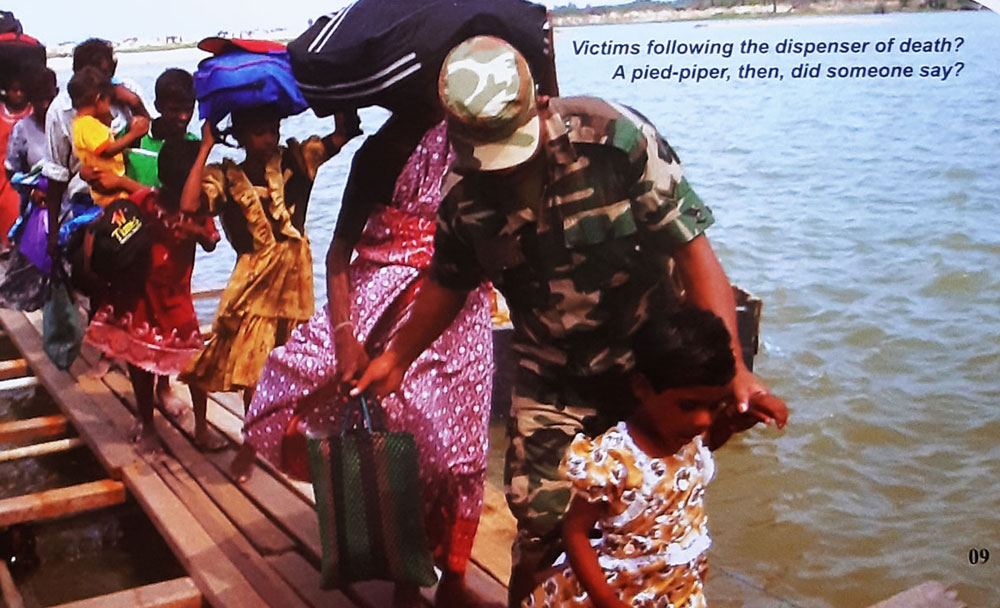
The LTTE regularly attacked or sought to attack ships transporting food, medicine and other supplies to the Jaffna Peninsula after the A- 9Highway was shut. The ICRC, unfortunately. refused to lend its flag to enable safe passage of supplies by sea. In January 2007, LTTE suicide boats attacked MV Liverpool, a civilian cargo vessel which was unloading essential supplied at the Point Pedro Harbour This led to other civilian vessels refusing to carry’ supplies. The Point Pedro Harbour was shut down since it was vulnerable to further LTTE attacks and a small fisheries harbor at Myliddy was renovated in record time with the construction of a new pier
by the Sri Lanka Navy in order to unload cargo.
Why bother, if the Government was not concerned about Tamils in these areas? Why bother if there was a genocidal policy?
So if the Government and the security forces are indeed guilty of crimes against humanity, as alleged by rogue players in the international arena, then the following would be some of the main transgressions:

THE CRIME OF CARE, KINDNESS AND ASSISTANCE

THE CRIME OF CARE, KINDNESS AND ASSISTANCE 
It would have been easy to offer the lady an Asprin or two, some tables to ease the aches and pains. This is ‘enemy’ treating ‘enemy’, some people still say. Something’s wrong, clearly. 
The story of all crime against humanity perpetrated by the Security Forces is contained in the gaze of the girl. Now that’s picture worth a thousand words 
There is a terrible word that comes to mind. ‘Perishable’. Here’s a man labeled ‘criminal’ who did not hesitate to be Total Father The child did not perish. Someone needs to be thanked but would any one turn tongue to be grateful to someone who planned an executed genocide? 
In the middle of shooting civilians, soldiers had time to help pregnant mothers deliver infants, and attend to both mother and child. Or are we getting lost in the story? 
The crime of feeding the hungry, sheltering the unnecessarily homelessed 
Who is giving? The criminal of course! And who is receiving? Most likely, some ‘liberators’. Strange criminals these; even stranger criminality. 
Those who were hungry were fed. Those thirsty were given water. Look carefully! These are the eyes, expressions and gestures of mass murderers. Or so we are told. 
HE CRIME OF PUTTING A RUTHLESS ENEMY BACK ON HIS FEET AGAIN 
This is no a sweat shop. It is a training facility fo ex-combatants. LTTE cardres, to be specific. It is a facility set up by the Sri Lankan Government, Giving skills that make for gainful employment and decent reintegration into society sits comfortably well with the intention to slaughter, apparently. 
Barbarians are uncultured creatures. They would not help ex-combatants belonging to the enemy camp to learn to express themselves through dance. No, they would do nothing that might put a smile on the faces of those who were trained to kill them. Strange barbarians, these. 
THE CRIME OF RE-CONFERING CHILDHOOD 
Togetherness has no place in a genocidal script. Neither does picking and distributing flowers so children can worship the deities they believed in. These criminals against _humanity, however, seem to be perpetrating the despicable crime of letting children be children, letting boys be boy, letting them play football, They are quite out of character . 
THE CRIME OF MAKING THE EARTH SAFE FOR FEET, WALKING AND LIVING 







WHAT THE CRIMINALS HAVE BEQUEATHED THEIR VICTIMS
In Economics, they talk of opportunity costs. Consequently, there ought to be a term called opportunity benefits’. Yes, it pushes us into the realm of conjecture, but then again we have 30 years’ worth of exarnple and pattern to work with in the matter ofreasonable extrapolation.
This is August, 2011. Let us imagine a Sri Lanka where the LTTE has not been militarily vanquished. This would then be a Sri Lanka made of anytime- explosion, slaughter of civilians, suicide bombs, assassinations, check points at every turn in the cities, fear-ridden lives, child-snatchers and the theft of childhood, a crippled economy that will not be allowed to get on its feet, in short a land of amazing potential suffering untold agony.
Now let us look at some pictures of a today fev envisaged would ever dawn, several years ago: snapshots, as it were, of a land rid of terrorism. A land blessed for many reasons. Let us count our blessings, or at least some of them.
This is the gaze of a vast majority of peace-loving people in the country, those who are grateful for what we have because they know the true dimensions of the opportunity benefit.
If you are Sri Lankan, then it could you that have recorded these observations. If you are not, imagine it is a grateful Sri Lanka speaking to you. Either way, read and see if you can empathize. If you can’t, go well.
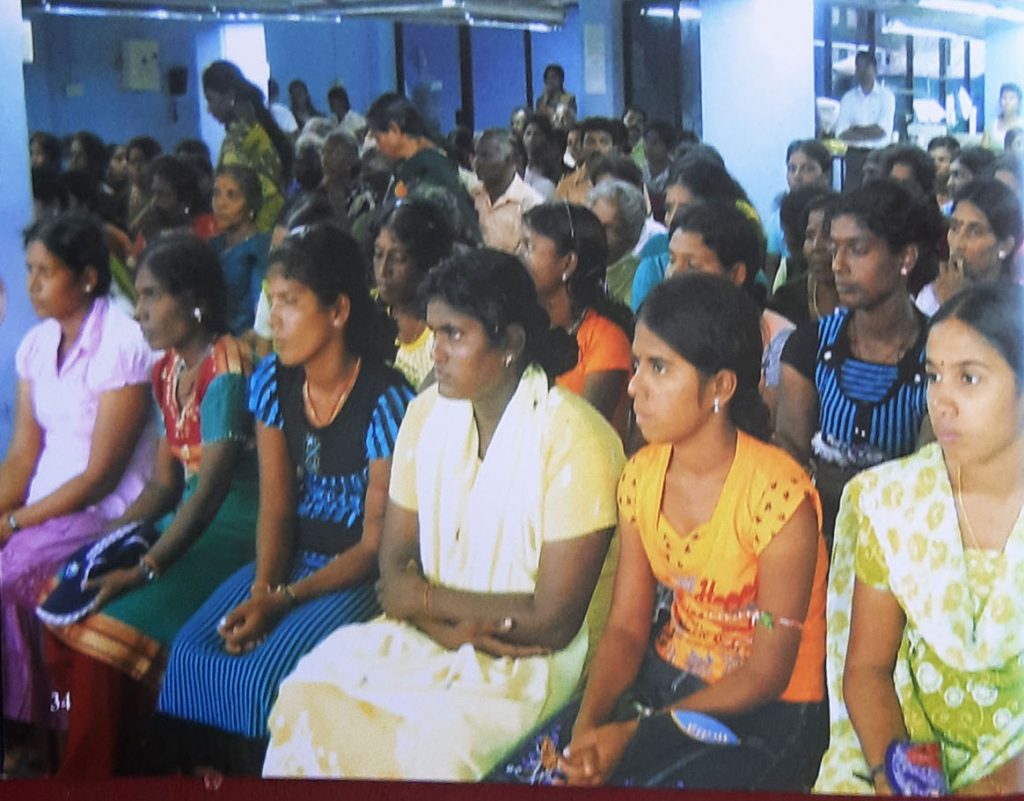
Blessed are the children, for they will not be snatched
Someone once proposed that when the first child smiled for the very first time, the smile would have broken into a thousand pieces, gone skipping along in a thousand different directions and that this was the beginning of fairies. I am thinking today of a different ‘first child,’ a child whose first smile brought tears to the eyes Of fond parents; happy tears and terrified ones too. That was a smile, which in their eyes, would soon break into a thousand pieces that would never be put together again, a smile whose owner would be forced to carry gun and grenade, ordered to maim and kill and Open him/herself to the real possibility Of violent death.
There are all kinds Of children. I know of 22 lucky children and two lucky teachers. On December 1 8, 2006, LTTE cadres stormed into a tuition class in Thirukkovil and took these lucky people away. They were lucky because unlike the 23rd child, they were all released because the child-snatchers had slipped up.
One of the teachers described the incident thus: ‘I was preparing these children for the examination, which they had to sit the day. Three LITE cadres forced the class and said they came for the When I objected, they slapped me in tt:c put a grenade in my mouth and assaulted me i ike an animal with a club. My fellow teacher Was similarly assaulted. We were all bundled into a vehicle, the LITE cadres beating the children, both boys and girls.’
They were tied in pairs and forced to march into the KanjikaidichiAru jungle. They were lucky, because they were released. Except that unfortunate Student No 23, to this day just a number with no name, like thousands of other Children that the LTTE forcibly conscripted.
That same day, though, the LTTE had accosted Some 300 students in Kawanchikudi and Kaludewala, who were returning home after the exam. It was a ‘join us’ demand. They were warned that refusal would result in reprisals. Many of the students had fled their homes in fear. They were the lucky ones.
Thousands upon thousands were unlucky. They were snatched from their adoring parents, trained to kill and expected to be killed. Some lived long enough to reach 18 and official adulthood, many died without a childhood. Even in the last stages Of the battle, the LITE strapped explosives to a child’s body and asked him to mingle with those who were fleeing LTTE-controlled areas. He was tasked to explode himself when he reached the Sri Lankan troops helping the fleeing civilians.
Exams didn’t stop the LITE. Christmas was good for recruitment. Pongal too. Children were kidnapped on the I Of June every year, and it does not matter whether or not the kidnappers knew it was ‘International Children’s Day’. They were abducted on the Of November every year. Yes, it doesn’t matter whether or not ‘he abductors knew it was ‘Universal Children’s Day’, as proclaimed by the United Nations General Assembly in 1954.
Every day was ‘children’s day’ as far as the LITE’s child-snatching units were concerned. Every day was hell for both child andparent. As Of January 31, 2006, the UNICEF recorded a total Of 5368 known cases Of under-age recruitment. In the first five years in which the Ceasefire Agreement was ‘in operation’ alone there were over 5000 such cases reported, some even as youngas7yearsofage! It is known that LTTE offices as well as the offices of the notorious TRO (Tamil Rehabilitation Organization) were used as recruitment centres; the TRO received a whopping US S to ‘rehabilitate child soldiers’. It is known that only a fraction of the cases actually got reported. It is known that refugee camps for the tsunami displaced were the happy hunting grounds as far as the child-snatchers were concerned. When 300 LTV E combatants were found dead after the security forces overran the in WeliOya, the vast majority were found to be children, mostly girls.
Today children in the North and East Of this country go to school. They know they’ll go home after school and that their parents will be there to welcome them. Their parents know that their sons and daughters will be home for lunch. It’s ‘Universal Children’s Day’ in the formerly LTTE-controlled areas. Every day.
Two years have passed since the LITE was vanquished. Had the outcome been different what kind of expression would we find in child and parent in these areas, have you wondered?
What kind Of tear or smile would grace the countenance Of a mother who has just given birth and upon a man who has just become a father? Would smile and tear break into a thousand pieces and if they do would they turn into fairies or gargoyles, be lifted by angels or by thugs? What kind of cut-paste would follow, have you asked yourself?
A child then was potential gun-toting killer, a cog in a military wheel, cannon fodder, and factored in the mindless equations of the ‘liberator’ as disposable. A child today once epitomizes innocence, vulnerability, hope and the future.
On February 22, 2007, the fifth anniversary of the CFA. I wrote, ‘(This) horror story demands closure; the monster that delivers nightmares to innocent children has to be laid to rest’.
There are thousands Of children who would not be going to school or indeed going anywhere had a different outcome materialized. They would be dead, most likely. Thousands more would be on virtual death row, courtesy the LITE. Some were unlucky.
Some are blessed and that’s cause for relief if not celebration.
Back then smiles broke into nightmares. Today, they can break into thousands and thousands Of flowers. Back then, smiles were not associated with hope. Today they reflect a future.
I know that thousands of parents in the North and East sleep better these days. I do too.
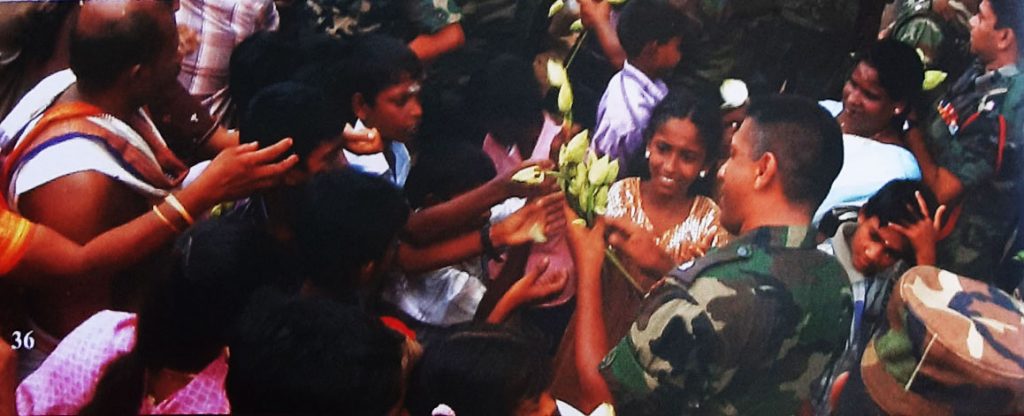
Blessed are daughters who arc not forced to bed with their fathers
Everyone living in Sri Lanka, including foreigners, be they tourists, business persons, professionals, volunteers, students, employees, diplomats and Other workers in foreign missions and UN personnel (and later, those working for the Sri Lanka Monitoring Mission), from 1983 to May 2009 were potential victims to bomb explosions. suicide attacks and Other crimes against humanity planned and executed by the LTTE. Politicians, journalists, academics and artists opposed to the LTTE were high-value targets, as were senior officers in the security forces and the Police. Needless to say, those in the security forces and Police were especial ly targeted by the terrorists.
Those living in threatened villages and Sinhalese and Muslims living in areas that the LTTE believed were ‘exclusive traditional homelands of the Tamil community’ were in a constant State of apprehension. They expected violent death every moment at every turn.
There was another ‘special’ category: the Tamil civilian. All things considered, they were the most unfortunate. Hundreds of thousands in this category found themselves residence in the middle of a firefight, frilled with landmines, artillery fire, grenade-tossing and soon. ‘Wrong place, wrong time’ was an ‘always’ thing and an ‘everywhere’ phenomenon.
Only they would know; I can only surmise. Some may have identified with the ’cause’, some not. Some may have seen ‘Sinhala soldier’. Some may have lamented loved ones killed by a soldier who was Sinhalese, never mind if the victim held a gun or carried a grenade. Some may have thought, ‘our boys, right or wrong’. Some not. But all, not some, lived in a territory where terrorist could drop fatigues, wear sarong and transform from combatant to civilian in a matter of seconds. Most were part of the water which the ‘liberator-fish’ needed, and/or part of the human shield behind which the terrorist took cover, placed heavy weapons and threw grenades. All, not some, if they were ‘able bodied’ were fair-game for recruitment. ‘Choice’ was not their comparative advantage.
Everyone, excluding the absolutely incapacitated, the senile, the infants and the pregnant, were put to use, one way or another. Or at least sought after. Some fled. Some could not. And it got worse the biggest myth created by the LITE (invincible) began to come apart. This was when the LTTE, severely handicapped in terms of human resources, decided that among the young, only pregnant women and women with infants would be spared.
Parents with young daughters Of marriageable age were distraught. There were no men around for them to marry off their daughters to. No men even to get their daughters pregnant. This is how fathers, out Of love for child and fear for her safety, were forced to impregnate their Own daughters.
No, not all such girls had to suffer the horror. humility and desecration Of things held sacred from infancy, through childhood. growing up and looked forward to tomorrows. They all knew, though. They knew it could happen and they had to make a terrible choice. Some opted to join the LITE.
Through it all. the I-TTE claimed it was ‘the sole representatives of the Tamil community’. Through it all, the LTTE’s proxies in the democratic mainstream, its supporters in the Sri Lankan Tamil Diaspora and its happy launderers in Colombo. played Ostrich. It was just ‘another of those things’ for such people. Like the forcible conscription of children. Like ethnically cleansing the Peninsula of Muslims. Like a thousand other terrible acts which were duly left out of the stories they blurted out to the world.
For the young girls who never thought a fathers love would push him to commit acts unimaginable, these are all academic. The resultant scars are invisible. Not recorded.
That time is gone. If there were any Tamil father and mother who prayed that such a fate would not befall them, then their prayers have been answered. Life returns slowly. Surviving reigns over living. There are men in the villages. Marriageable men. There is love and love- making. Even under harsh circumstances. Young girls do not have to look into their fathers eyes, ask from father and self the question that would not be voiced, and wonder whether within those circles made of and for love-gaze, there lurked fear, guilt, anxiety and self- condemnation.
Young girls do not have to worry whether there will come a time when they have to talk about paternity to their children.
This was not so in May 2009. And had things not ended the way they did, then there is nothing to say that young girls and their parents and indeed an entire community would not have to contemplate or be horrified by the unthinkable.
This is May 2011. It is a different country. Different villages. Families can be families, even in the midst of suspicion and doubt. There would be a thousand questions and a million wants for no human being is ever fully satisfied. There is little to gain, after all, from the consideration of relative marits one glass of rice-gruel given by the LTTE compared to three cooked meals a day away from gunfire and scream. There would be, I am sure, random moments of thanksgiving, if not uttered as shout or even whisper, echoing in heart and mind. Not to anyone in particular, perhaps but in appreciation of a time that is not the time that was.
This is May 2011. A young girl is, as write looking at her father without any question marks hanging over mind and heart. A gaze is being returned, innocent as a new born babe. A wife and a mother is smiling or making a snide remark of some one being someone else’s favorite. It is not the best of times, but these are better times than days gone by.
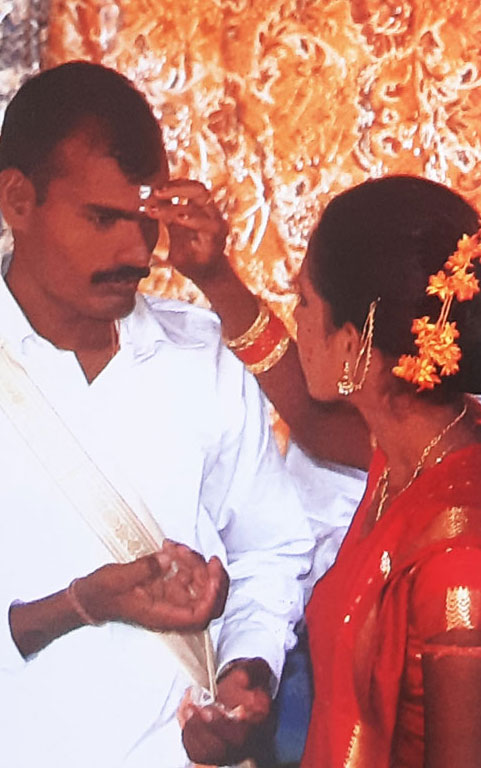
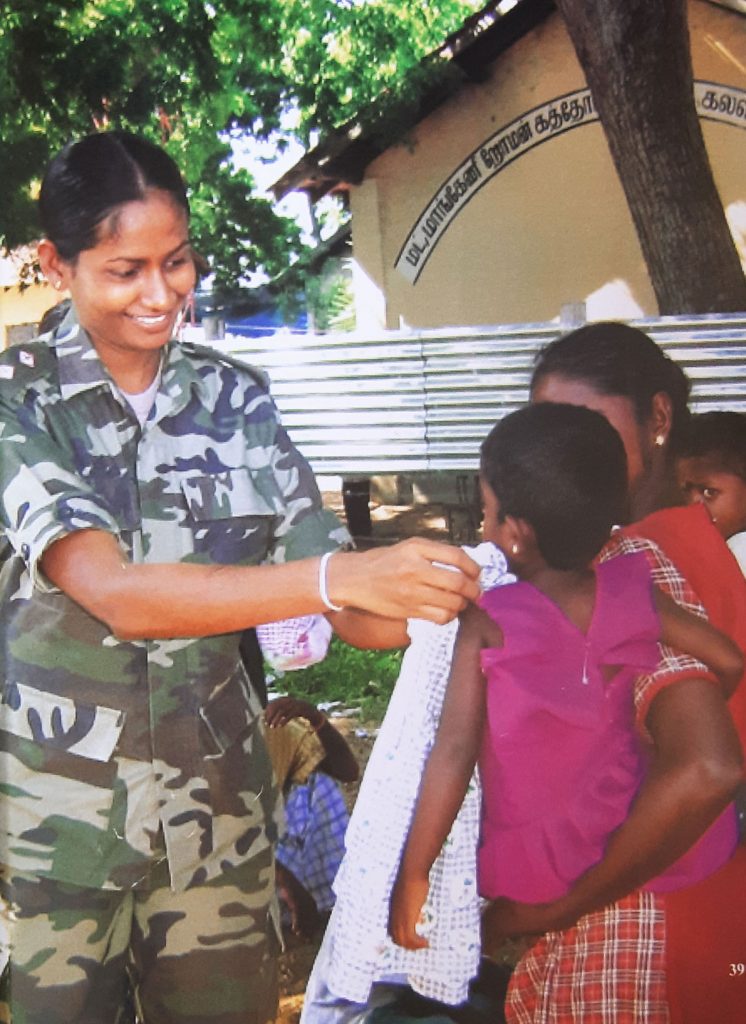
Blessed are the Tamil politicians for they can recover their tongues
Power imbalances make for two things: voice and echo. The degree and nature Of the imbalance determines the volume of voice and the throw back compulsion of wall and the distance the echo travels and of course its clarity. Complete servility Or a monumental slant in favour of one entity over another gives us a ventriloquist and a dummy.
For a long time, for all rhetorical claims of them representing the future and reference in fond terms such as ‘boys’, Tamil youth were seen by the Brahmins of Tamil politics, i.e. the Angl ic ised, mostly Christian, Vellala politicians Who either lived in or hailed from Jaffna. as means to an end. They were add-ons, the energy—givers, the ‘necessary numbers’. As Often though, things did not unfold happens, according to plan. The baby that was fed with communal poison and whose nails were allow c.f to grow, clawed and Stung the parent. Ll-he creator, by and by, was overpowered by the created. That. ladies and gentlemen, is the nutshell version of the rise and fall of the TUI-I: and its later avatars, including the ITAK,’TN A.
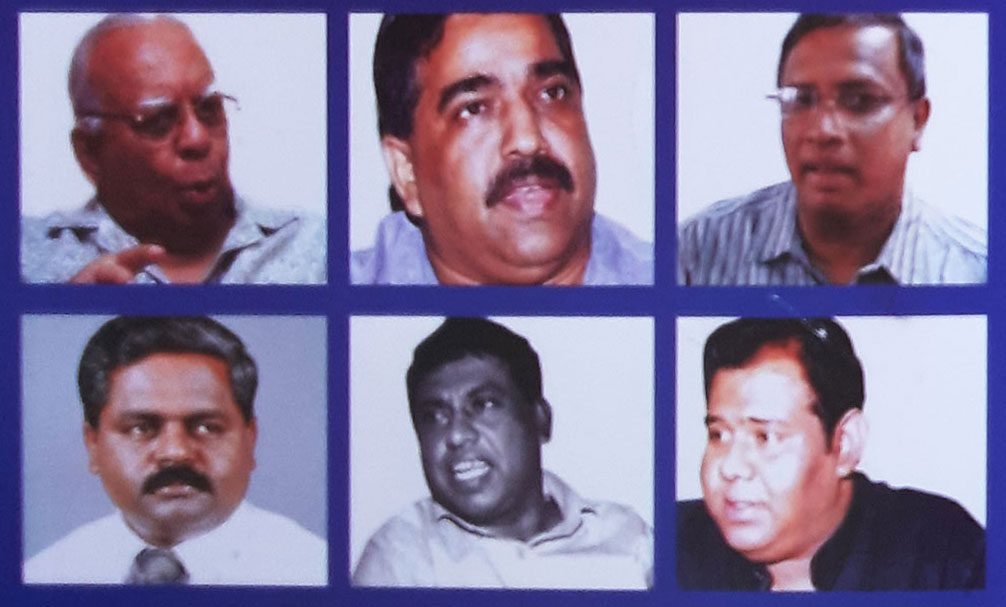
From Amirthalingam to Sambandan and perhaps, in time, to Sumanthiran, not a whimper of condemnation did the world hear about the atrocities by the LITE. Not even when key leaders of that party were killed in cold blood. The perpetrators were referred to ( at best) as unidentified gunmen. There was of course condemnation, followed by a long wail about problems not being addressed and emphatic chest-beating about not being ready to give up the struggle. It was a script they had to pull out regularly for decades. Until 2004, that is.
The year saw the formalization of reality; ttv B•wer imbalance was recognized and acknowledged- It was put in black and white. There thereafter. no need to indulge in shy making or take refuge in tortuous word-twist punctuation rearrangement. The Tami I National Alliance, in its election manifesto of 2004. made it abundantly clear that it was Prabhakaran’s mouthpiece. ‘Shame’ was duly abandoned. Those were the shining days of ignominy.
Dignity that is squandered takes time to be regained. Two years after the slave driver was taken out of the equation, not enough time to have passed for slave to convince himself that the relations of production have been transformed. Having been echo for so long. it is perhaps difficult to think of ‘voice’ as For tongue to bend to speak of duress, disagreement and articulate condemnation, echo nee& to find tongue. The LTTE-echo is getting them and even though the confused that comes out is a throwback to the Square (he of the Chelvanayakam Doctrine, ‘A little now more later’, and continues to treat myth as fact and regurgitates Old lies.
Most importantly Tamil politicians can now truth and lie of their choice without atout being shot dead the next LITE assassinated thousands of opmysed them. These included academics. Some had known Many were names known only to family They were unarmed. They weren’t militants. Ttey were not combatants. They were just peaceful objectors who held different views.
The TULF/TNA knew what the LTTE could do to the unarmed. They knew what they had done to the unarmed. They knew what they had done to those who were those who had the guns and had undergone relevant training. The LTTE annihilated the TELO. and rendered ineffective the EPDP, the EPRLF and PLOTE It is in this context that the likes of Sambandan and Sumanthiran regularly touched Prabhakaran ‘s feet in veneration.
That’s all gone now. The ITAK/TNA is to admit that Prabhakaran was master and it was s la ve. On the other hand, they are not interjecting ‘LTTE’ after every other word in the sentences they utter and write. There is no need now to pay obeisance, no need to acknowledge and Salaam, as they were wont to do not too long ago.
Those who have voice can confess to error. The TNA is yet to get there of course, but that which had robbed them Of humanity and dignity, the LTTE, is no longer around. Their servility to anti-intellectualism and penchant for articulating myth belongs to them; they are not Prabhakaran’s proxies any more.
When the monster spawned by the TULF found voice, the leadership of that party gradually lost their vocal chords. The TULF’s political link offspring and heir, the ITAWTNA was offered the echo-option when the LTTE was vanquished, and they took it. Today that can legitimately dream Of becoming ‘voice’ once again. I am yet to hear them express appreciation to voice-giver or, let’s say, those who make it possible for echo to be replaced by voice. Perhaps they lost integrity along with voice. Perhaps they were born without it, who knows?
Those who have voice can articulate grievance.
All we knew what they had done were those who had the All we know is that voice is better than echo. and that those who are able to voice Without being asked to voice are truly blessed.
Blessed are those who can walk and those on crutches too
It is now two years since the entire country was liberated from the threat of terrorism. Slowly but surely, normalcy is returning to this land. As is prudent in any society that is emerging from a 30-year long conflict the Government has adopted a strategy of phasing out security mechanisms. ‘Prudent’ on account of the nature Of the enemy and the fact that thousands of people associated with the terrorist outfit mingled with those who were not when the security forces finally rescued them.
One by one, however, the barricades have gone, checkpoints have disappeared, and summary stops gave way to random checks which too became less and less frequent. We are not completely free of these security measures, but there is certainly reason to feel freer than we were, less on account Of the downgrading of these mechanisms than the removal of principal threat.
Conflicts leave scars, some visible and some not. There is greater scar-visibility in places where the fighting was most intense, in our case, the Northern and Eastern parts of the country. This conflict, nevertheless, spilled over the relevant boundaries in many ways. First, anything and anyone was ‘fair game’ to the LTTE. The Central Bank was attacked, a President was assassinated, and therefore the point does not require elaboration. It ‘spilled out’ because those who had to take out the enemy and save fellow-citizens came from all parts Of the country. Economies depended on the salaries of the troops, and their death or maiming caused grief. Yes, some scars are more visible than others.
We move on, though. As so we should. That which was damaged gets rebuilt. The dead are remembered by those they left behind. Grief is not a collective thing. It is personal, regardless -of the identity of the dead or the aggrieved regardless Of loyalties and preferred political outcomes. If we lamented mass slaughter in greater degrees of collectiveness then, we now focus, if at all, on our individual losses, Here Colombo, as the city becomes more beautiful by the day, conflict-signs have all but disappeared.
Invisible, however, does not mean ‘non. existent’. There are times, for example, that we remember, if something triggers reflection. Today is a day like that, as the second anniversary of war-end is celebrated Remembrance came to me in a different way, though. I saw a young man on crutches. I immediately thought, ‘Johnny Batta’, the name given to the anti-personnel mine that the LTTE buried in their thousands all over the Vanni and which cost hundreds of soldiers their legs.
I remembered, then, the tireless and dangerous work carried out by the security forces to clear the Vanni Of landmines, one square inch at a time, with no map or reliable information about location, those responsible for burying being dead or (naturally) averse to offered guide- services. My thoughts also went to a day in either April or May 2009.
At that time, the LITE leadership had decided that it could no longer depend on the support of Tamils living in areas under their control. The days of volunteering were long gone. The retreat that began when the LTTE lost Silavathura marked the beginning of comprehensive hostage taking. All civilians had to flee with the LITE leadership. As the troops moved relentlessly forward, the LITE had to increase the speed of retreat. They were hampered by the slow. They knew they could only be as fast as the slowest in the group. The slowest, naturally, were those who had lost their legs to the very devices the LITE had planted to stop or delay their pursuers. There was an easy solution. ‘Easy’ because it was the LITE that had to come up with it and because the LITE is what many always knew believed it was.
Some 40 women, all on crutches since they had all lost at least one leg, were ordered to get into a bus. Then they blew it up. They were all Tamils; Tamil civilians injured by devices set by terrorists in the name of liberating the Tamil people, terrorists supported by word, action and funds by sections of the Sri Lankan Tamil Diaspora and whose crimes were regularly whitewashed or responded to with silence by the Tamil national Alliance. They were all, in one massive flash of fire and brutality unburdened of all scars, visible and invisible.
We are told to be grateful for small mercies. We are told not to complain about the lack Of shoes, because some people don’t have feet. These are ‘grin and bear’ recommendations. They are not always sourced to a will to subjugate though. Right now, I believe those who can walk and dance are blessed. Thinking of the 40 plus women whose bodies were broken to pieces and who were instantly robbed of the right to dream, I think even those without legs, can feel blessed.
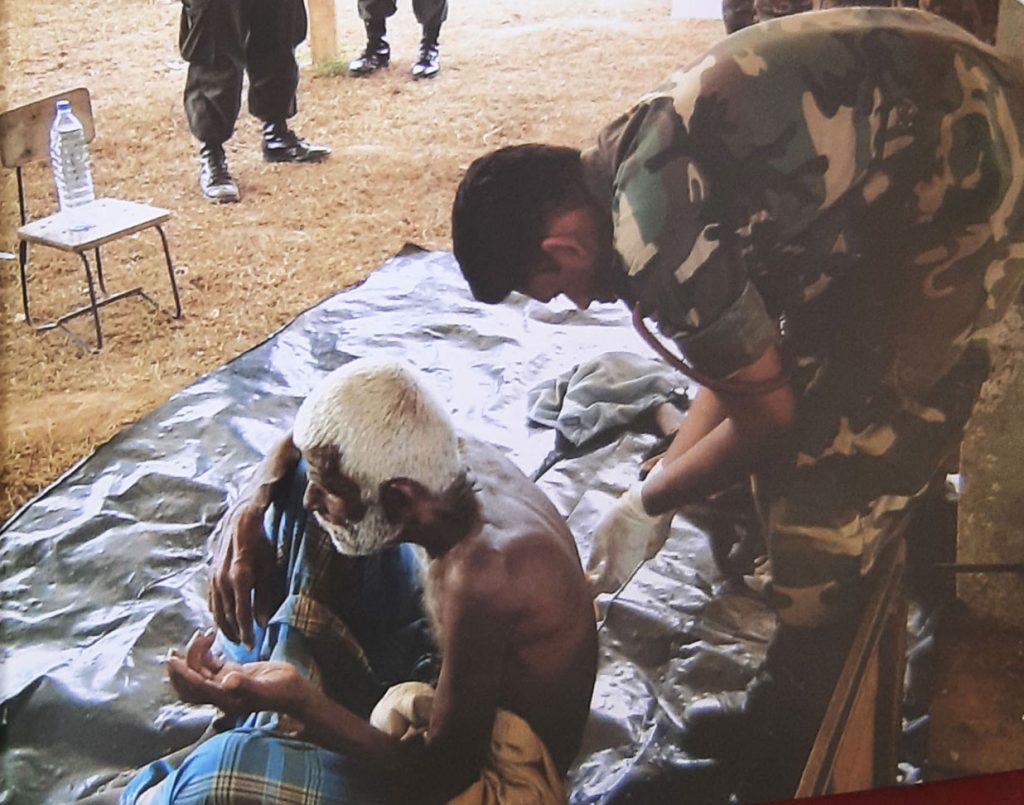
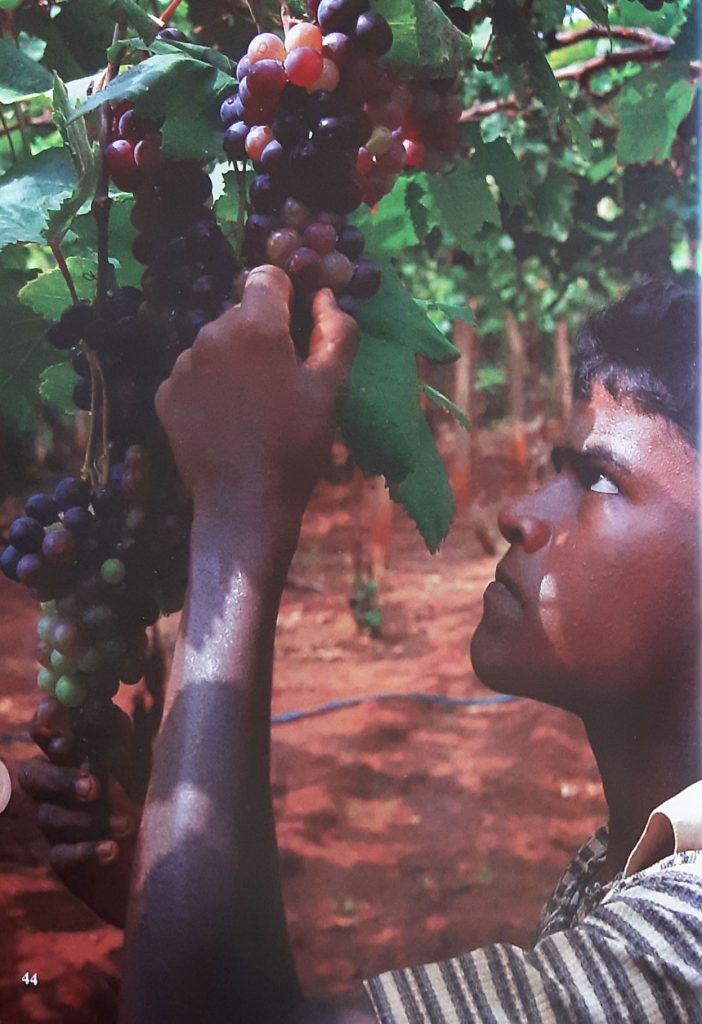
Blessed are the resilient for they shall protect this land and our children
The days following the elimination of the LTTE leadership were justifiably joyous for a nation that had been plagued and held hostage by terrorism for three decades. Joy’, however, is relative to place and person. I am thinking about the three hundred thousand plus who were in IDP facilities at the time.
True, they were no longer being held hostage by a ruthless terrorist outfit that did not think twice about axing limbs of 5-year old trying to flee or opening fire on the elderly, the pregnant and the sick as thousand (including LTTE cadres) Saw perhaps for the first time the true face of the ‘liberator’ and crafted upon that terrible countenance megalomania, revenge-intent and self-preservation. They had left a diet of one glass of rice gruel a day. Their children would not be taken from them. Even if what they arrived at did not have ‘Paradise’ written all over it, they knew they had escaped from hell and hopelessness.
Still, life ‘after’, did not seem rosy in the least. In the early days, facilities and resources did not match will. The massive influx proved hard to deal with. Feeding three hundred thousand people, caring for the sick, bringing together families that had got split in the mad rush out of ‘s hell was not an easy task. The government and the security forces had to make sure that water and sanitation met minimum standards, even while being hampered by the reality that many among these people were LTTE cadres or sympathetic to their cause and ever conscious of a trigger-happy international community ready to fire accusation mortars their way.
It was easy, back then, for bleeding heart I/NGO personalities who had bet on the LTTE prevailing Over the security forces, to complain about the situation. accuse the Government of runmng open air prisons, wail about freedom of moment being curtailedetc. They were lucky.
Un-elected and answerable to no one except those who pumped dollars into their bank accounts, they did not have to deal with logistics associated with the above reality.
I visited the Menik Farm IDP facility in Cheddikulam in July 2009. I realized that had it not been for the discipline and structured authority Of the Army, things would have been far worse.
The authorities were in constant communication with the I/NGOs and UN agencies that had offered to help but naturally on their terms and not those of these agencies whose track record in helping the LTTE was common knowledge. By that time, there was order. The day-to-day was streamlined. Conditions in these facilities were not ideal, but still better than in some other parts of the country.
I was impressed by the untiring efforts by the security forces to make sure that everyone had food to eat, that the sick were taken care of, that families were reunited etc. I was impressed by the volume of relief items that were pouring into the area. I was impressed by the fact that there were dozens of doctors who had volunteered to work round the clock attending to the sick.
I remember being horrified by some of the stories these unfortunate people related. I was impressed that despite all the trials they had dignity, self-respect and humanity. Thinking back, I believe that nothing impressed or inspired me more than how these people asserted their will to live and prosper.
I visited all the relief facilities. In each unit, regardless of size and population, I encountered ‘education’. There were hundreds of teachers among the IDPs and many principals as well. Naturally, there were thousands Of children. Each and every one of them had ‘returned’ to school, so to speak, alrnost all of them after many months. The authorities facilitated it all. The largess of their fellow-citizens and well- meaning non-governmental organization had ensured they would not lack in stationary. The people themselves, despite all the trauma they had been through and indeed had not yet Overcome, had decided that the children must learn, even under the harshest of conditions.
There were ‘classes’ under the trees and inside tents. They were organized according to age. The children were being taught English, Tamil, Mathematics and Science. Some of the instructors were teachers attached to the Education Department. Some were older Students or adults who had been trained in other professions. I was impressed by the enthusiasm of the teachers and the students. I remember thinking, ‘this country has reason to hope’.
That was resilience. Resilience is what our nation is all about. We’ve suffered enough but have always made sure that the foundation of our civilization has remained intact. Five hundred years of colonial rule which included the killing of thousands, burning of libraries and destroying of temples. had not succeeded in destroying the faith of the people and their sense of identity. A tsunami did not demoralize people into mass Suicide. Two insurrections did not see the consecration of anarchy. A thirty year long war against terrorism had not made embrace among communities impossible.
NO, we are not a ready to roll Over and die, whatever the odds. In Cheddikulam, the teachers were not unlike teachers elsewhere. teaching under different and far more hospitable circumstances. They were dedicated, disciplined and strict. Worthy Of utmost veneration and admiration.
I have no idea what their ideological preferences are. I don’t know if they identified with the LTTE or with the idea of Eelam. It does not matter. What counts is that they exemplified something beautiful about the human condition: the will to live, to do one’s best, to think and live ‘community’ and ‘solidarity’. To me. these are the same qualities that those who contributed in whatever way to rid the country Of the terrorist menace were endowed with.
I know we have our identity preferences. but we also have all that it takes to be a single people.

Blessed are the rain-makers for they make the earth yield hope
I was not anywhere “Ing stages of struggle to save thotsands held hostage by LITE. In a-t the •war’ to i.e. in terms Of Fople I knew who did ttx Fstion marks that &scended like ttr rains flooded and Ensiblllty on account of terrorism spilling over ‘contestaf territory and all wrecking everything associated with the word ‘civilization’. I believe They to bullets from the would-tv li&rator. the LITE. and run Into the arms Of the purported ‘enemy’. the Sri Lankan security forces. Those with families. had to make split- second dectsrons aN•ut pnoritres: whrch child to carry. for exarnple. Some would have to chex•sc tvrween mother and child. the Sick and the elderly, the wife and the father Self- preservation or the protection of the loved. some would have had to ask themselves and answer in firmly, though, that all natlon and all the matterofasccondorless. In therush.some communities are made of roughly the same would have stumbled, some would have fallen proportion of crooks, tyrants. sycophants and and those who didn ‘t would have had to dec cowards, and trr same percentage. roughly. Of whether to tarry and risk death or keep runn ing kind. compassionate, wise, generous and heroic leaving behind mother, wife, child or friend. I wasn’t anywhere close to the Nandikadal I was not anywhere close to the Nandikadal Lagoon in May 2009, but I am con v inced that Lagoon in May 2009. I saw footage of people there were many who chose ‘poorly’. that is, fleeing the I saw them helped by soldiers against all logic and all wisdom. confoundlngall who were well aware that among the escapees theories about the primacy of self-preservation. were thousands who were either trained Amongthem.manywouldhavepenshed. Some terrorists. had hellxd them in any number of may have stopped not to help • loved one ‘ but ways, identified with their objectives and/or total stranger, in the same manner in which saluted their methodologies. I saw fear and hundreds of soldiers would have died üying to doubt in the eyes of the rescued. There was save those who were seen as ‘enemy’ or those resignation on some faces, I noticed. I saw whosawthem as ‘enemy’; not only because they gratitude too. Relief there was in abundance. were following order. but they were different Courage and character cameundrsguised. And kindsofhuman beings. And. I am certain. there were blank faces blank eyes, lips that were LTTE cadres who trained gun on the would not move to smile and brows that did not fleeingbutcouldnotpulltrigger. wrinkle to indicate any sentiment. no idea of the average sense of fear otherwise pedestrian album by Nanda amongthosewhowerelaterrescued. 1 haveno Malini(‘Pawuna’or’Wind’): Vahinnatahekina„, (iflcouldbetherain). reason and regardless of ideology or nadetholagasinahavakvee: p n a th udi n thudane/aagathah eki van amalakvee. Nidannalahekinamdenelh’hulas abaelunasuhha.sihlnalakvee; ga» apuhudana geelhayakvee. ‘ It is a wish and a recommendation about a different kind of being, encountering and embrace. The following is a rough translation: ‘If I could. I would be like the rain, falling upon the parched and thirsty earth and village; I would, if I could, boil like a pot of rice in a hut that hasn’t Seen food. If I could, I would reside asa smile on the lips ofchildren who are in tears; I would. if I could, blood from every bough as flowers whose picking is not forbidden. If I could I would sleep beneath eyelid as a pleasant dream that will turn true; I would, if I could, be a song that goes from door to door awakening the entire world.’ Our nation, our world, is not without individuals who are like rain that falls on earth decorated with radiating cracks, like rice in a hungry household, like smiles upon faces that have only known tear-stain, like flowers that can be picked, like songs that kindle hope and tomorrows. I am sure that if there’s reason to hope for a different kind of national resolve, inter-communal embrace and a tomorrow that is determined not to return to war, it is because such people lived and still live, because such people lived and perished so others could live and dream. We were a land that was desert-made and out-of- bounds for flower and song. We were a nation that dreamt of drizzle but was given flood. We were a people who wanted to smile but whose lips bent involuntarily into grimace. We were a no-hope community. For three decades. In the aggregate. that iv Through all ‘here ram There was flower and herc …re smiles and dreams. There was Ing and gr.’lng unlll ‘herc ‘-a a. rv,’h.rvg Truorc ‘o grvc. neutralizes the poisons that Ignorance. arrogance and hatred ha”‘ sown. ‘l his is why wc are still a nation. This is why we can remember and yet forgive one another. This is why. I am certain. wc can talk of togetherness. ‘Togethernesscs• too, in fact. And this is why we don’t need to be lectured to. prescribed for and made to inhabit the reality-versions dreamed up by those who do not care, did not sacrifice and did not embrace. The rains that will slake our national thirsts have to fall from our own skies. No one can make us smile, except ourselves. No one can make the harsh earth yield flower and grain, except ourselves. There’s rice on the hearth. It should mean a lot. Some vote with their legs, some just cannot April (in most years) is the traditional New The Big Exodus took place later. In April it was Year Day for Sinhalese and Tamils in Sri Lanka. still ‘Deterrent Punishment Time’ as far as the It is a day ofrenewa/, celebration, forgiving and LTTE was concemed. A young boy, a child in forgetting. compassion and humility, empathy fact, was stopped in his tracks as he fled. His left and solidarity. It is THE NATIONAL leg was chopped offatthetopofthethighand FESTI VAL Of Sri Lanka and, to my mind, is the right was severed just above the ankle. second to no Other festival or celebration in the Right before the eyes of his parents. Every matter of affirming identity, belonging and parent would immediately see in that wri thing sense of nation. It is a day, from this day and dying little child, the angel that he or she onwards, tha t will be made with blood, tears, once cradled, sang to, smiled with and helped screams and anguish as it is with all oftheabove, crawl, walk and run. for I noticed just now the ‘date’ of an incident recorded on camera that I have replayed many This is not the only horror story scripted by times on my computer and in my mind. Each terrorism. War is not a fairy tale. The brutal are time with tears and renewed resolve not ideology or community bound. Cruelty is encapsulated in the words ‘NEVER AGAIN!’ Here’s the link for those who are interested and, let me warn, who have the stomach for witnessing what ‘Liberation a al the LTTE reallymeant: http 4/yahalu-yeheli-fate-of-boy- who-tried- to_ 1 7.htrnl. This happened on April 14, 2009. This was after Tamil civilians held hostage by the LTTE, realizing that death was what the LITE promised, began to do whatever it took to get away from the clutches of the terrorists. The LTTE by this time had moved to the No-Fire Zone demarcated by the Security Forces, placed their guns among the civilians, including embedded in it all. On April 14, 2009, however, a little child was stopped. He would never walk again. Thankfully, he would never scream again either. Watching this video-clip, however, I got thinking about feet and walking. War made people walk. Long distances too. Some were forced out courtesy ethnic cleansing by the LITE. No Tamil politician has ever shown any remorse about this. A friend observed, ‘And never ever (any remorse) by any so-called human right bodies, (the) UNO, super powers etc.: ‘Mage amma. amma- nuhngeamma summa’ (My mother is ‘mother’, your mother is nothing’. women, elderly and the sick. The Some, both civilian and combatant, were made civilians had to risk everything and flee. The them. Ruthless to the tors• used whatever death-obtaining instruments they could lay their hands on. Thousands were shot dead in cold blood. helped by the to fly out of the physical cage that is called body’, by the combatants, either through assassination or crossfire. It did change the demographic composition in the North and East, yes. It benefitted the Tamils more than it did the Sinhalese and far more than the Muslims, most of whom are still One can say ‘this conflict was precipitated by intransigence and chauvinism on the part of the Sinhalese’. One can say ‘It was Tamil Chauvinism beginning with PonnambalamRamanathan, honed by S.J.V. Chelvanayakam and armed by Prabhakaran that declared war’. The bottom line is that right now, the demographic today, June 8, 2011, composition has been altered and those who left are highly unlikely to return. Not even to an LTTE-free terTitory, a ‘traditional homeland’ a la residence and/or deed. Today more than halfthe Tamils live outside the North and East. Those colonially drawn lines of division which have no basis in history, economic efficacy or physical geographical attribute (river, mountain, valley etc), are not made for ‘devolution’, but for land-grab, nothing else. In practical terms, it would be, as my friend observed, ‘Otuwata koodaramataoluwawithrak dagannatadunna wage (allowing the camel to put (just) the head (into) the tent; after some time the camel simply gets the whole body inside the tent and chased the Arab out.’ The reference is of course to Palestine. Devolution therefore, ladies and gentlemen of Eelamist persuasion, I am afraid, has been voted out by the Tamils for all practical purposes. By their feet. Willingly or unwillingly. A repeat of the adventure by a new set of chauvinists and thugs who would no doubt be aided and abetted in their designs consciously or unconsciously by their Sinhala counterparts, would only lead to a second exodus. This time, the exit would be faster. No one, I am willing to wager, would want to be corralled into a No-Fire Zone by a No one would want a video-clip such as the one cited above to be made of his/her child. That child. in death, is a gruesome pointer to what we as a nation, together and alone, produced on this beautiful island ofours. It is what we are capable of. It is what we should avoid at all costs. The Tamils have walked out on ‘devolution’. The nation must walk out of parochialism and chauvinism. We need to stand together and not walk away from each other or walk out of ourselves and the villages where we were born and played as children. We need to return to our humanity. Arantala»a is a tcmplc called ‘Never Again’ are villages nanvs are only by and a few others “vrng m ttæ Twenty four yean ago. few nonc In Colomtv» would have of a “lage called Nuwaratcnnc Twenty years ago. to day. IC. of •MTVth’ng whwh hctrvd that nan•e to households the radio and newspapers Tbc name was ment•oned pixe to thn “l lage Tbc was forgotten those who wcrc abdw•tcd wcrc k in cold a different plx:c That a Arantalawa. A bus 34 bikkhus by 4 others was ambushed on that day near It the I ltxrators to revolutumanes to ottrrs. calla’ sole- representauvcs of the Tamil people by theatr here thought to mvtrwibic then and nght to of There were 20 of with guns swords “&red to the vehicle “No of Arntaiawa liberu•xs 30 tKvv•cc tiw.u In cumbent o f t he Vea Sn were to thew next of gunn•d by no’ •n ‘Rotated of ‘iter•twm The I camed out hundred’ of Smhala areas LTV consutered were and homelands’ of the Tamil cwgnnnmrty Thr•. ladre•• and gentlemen. tvfore the term •ethmc cleansmg’ cruered of con resolunon. ‘Arantalawa’ mentioned and remembered bccatse the name has a Ivrwal ring to ‘t It ‘s rcrr.•rntvrcd also ‘t a gruesonv El. It IS ‘t was. may I av. colourful M ‘l Irons are familiar. aner all. wrth ttv from that A row ofbruulty mur&rcd young h’Akhu€. thew yellow rotv,s makes eye-c.aEhmg No Tun•l With even a drop of humansrv m htm or With the LITE and its thn rrwmxnt onwar•b. would lave anumg those who dld. clum they were hunun la-ked m There ail. a hunæ sueh It the g•crvrai of by • Ar—wa’ a m •overall’ that a follower b was ‘first’ of I Sew’h It was not only Sinhala Buddhists who earned the wrath of the and were executed thus. Muslims were slaughtered in their hundred while at prayer inside mosques. That’s how ‘Kattankudy’ became a familiar name. And it was not only the LITE that perpetrated such acts. There have been many imstances where soldiers. either under orders from superior officer or on account Of indiscipline, have attacked villages where Tamil people resided. Villages have fought one another, extracting eye for eye that was extracted. Often by total outsiders in both cases. Wars are terrible things. Guns don’t think. Testosterone compromises Twenty four years ago, saffron coloured robes turned chilliered. Today. wecanask, ‘for what purpose?’ The LITE did not win anything for the Tamil people. They only conferred disgrace on that community and were considerably supported in this by cowardly Tamil politicians and quack academics who went along with Eelam myth mongering because they were virulently anti-Sinhala or anti-Buddhist. Tamil people are not to be blamed for crimes against humanity perpetrated by a group or person who claims to represent then. Neither are the Sinhalese to blame for the excesses of undisciplined troops, their sycophantic Today. ‘Arantalawa’ tells us only one thing: we cannot go back to that time. All communities have been made to un-belong on this land, or else forced to inhabit characterizations that are secondary or irrelevant to their lives. They’ve not been allowed to speak. They’ve been spoken for and spoken for by demogogues Arantalawa’ today is not just a gross reminder of the cloud that was hanging over this land for thirty years. raining bullets and dread, it is a symbol of what could happen again if certain paths known to lead to blood-letting are walked again. ‘Arantalawa’ is a temple to the idea ‘Never Again’. And this •never again’ must include claims that cannot be substantiated, insensitivity to one another’s doubts and suspicions, tendency to frill grievance and to ignore grievance in its true dimensions, the deference Of resolving both specific and general citizenship anomalies in favour of eyewash and endless hair-splitting over things packed with rhetoric and poor in reason. On June 2, 1987, the earth in a then unknown piece of earth in a land whose blessings are ignored or vilified, saffron coloured robes turned chillie red. Twenty four years later, we are as a people, have moved on. Moving on, though. does not preclude going back. If anything ‘Arantalawa’ should serve as a vivid and indelible image that makes us reject the pathways to madness and bloodletting. Blessed arc thosc who gave despite threat, abuse and scandalous pilfering In the mid-eighties, when the then Governrnent was facmg a growmg threat of by-any-means that incltukd bomb explosions targeting civilians, assassmation of Vomrnent politicians, academics and professionals, argi guerrilla attacks on the security forces. I remember Pres’dcnt J.R. Jayewardene quoting Marcus TulliusCicera. ‘Laws are Silent tn tune of war’. My father. a senior rnember of the Administrative Service, observed then, ‘this docs not mean that adrmnistrat•on should cease’. It came under threat, yes. apparatus. regardless of nurnerous obstxJe,s to smooth operation, did not stop. then not during the last days of conflict. Throughout the thirty years ofconflict, from most senjor public servant nght ‘bwn to well as m other state rnst’tunons and services irxludrng Ox-tots. nurses. labourers and others were pagi by those who ran the so-called de-facto state. The State of Sn tanka paid therr “lanes. The people of Sn l.anka paul taxes to make ‘t possible for such salancs to Tbc Governnrnt Agent of Mullaitivu during the last stages of the humamtanan operation to revue the hundreds of thousands of civilians held hostage by the LTTE. Ms. ErneJdaSukurnar. has boldly stated what the I.TTE dui and did do dunng those terrible days. She has revealed that the Norwegian based LITE PennpanayagamSivaparan ahn Nairyavn. one of the main rnovers and of current onslaught against Sri Lanka m international forums. had threatened ber durng ttv final rnonths of the battle. She claims that she was urged to cease operations, resign r»st and leave MullaJtivu. If anyone was interested in starving the civilian population trapped m the area, it was the LITE, her testunony reveals. was hesrtation the part of the Govemrnent or Governrrvnt Servants wtEO it cartE to ensuring that the lowly. thankless but nevertheless irM•spensiblc GramaN iladhari, everyone Even during times of intense battle even in areas that the LITE controlled, ttv civil administration never ceased to function. Even as the LITE claimed it was running a Tk-fxto State’ with Killinochchi as the ‘De-facto Capttar, even when its Dollar Euro hen in Colombo. certain sections Of local and international media and even of big players in international community endorsed such institutuns perfcxrrrd bec— r—cesvovuw by SEcäive gove— &hvwy of eva it wu LITE and consume the same. Those in the „q—rve PI— Sevee did go hungry or sick (Eprived of Voper “Edical treatment relevant TIE Vanni enjoyed a in Maha Seagn of 2008. There was enough bod. both produced locally and s.lied from CRtrr parts of country coutesy goverrunent nxhiæy. There is cmly that a Governrnent cui cirannstnces. The LTTE attxked nædicine and other LTTE robtxd g« through did ttæir to TEy put Civvlins ma raim ofrice gruel the troops not moved In at great n sk and cost to fX’litate the escape of these cm llans. over a hundred thousand would have Of starvation. Courtesy the LITE What is trnrvwtant here is the commitrnent ofthe Government to do the best it can. What is smp»rtant the commitment of the humble public servant to do the job at hand under the most trymg of circumstances. including the nsk ofbetng summanly executed by the LTTE. Immediately after the LITE was eliminated and the saved hostages transported to welfare centres, there was an outpounng of generosity from all parts of the country agenctes devoted to humanitarian assistance dui thew part. The Government, With the help of the secunty forces, channeled enormous resources to ensure that the basic needs of the hundreds of thousands In these facilities were provided for Doctors volunteered to serve in these areas. Ordinary people joined the more orgamzed relief efforts. Dry rations, clothes, stationary, medrcmes, drinking water and other essentials were sent to these facilities by the lorry-load. The generous entertained no illusions that among those they sought to help were hundreds of ex-LTTE cadres and many who chose to be silent on the efforts by the state to ensure there was enough food and medicine even in areas controlled The disingenuous sections of the Sri Lankan Tamil Diaspora and the double-tongued whiners ‘shnekers’ determined to punish the Government because the LITE did not prevail over forces. as they expected and’or hoped. the eyes to see these truths and lack the Integnty to acknowledge they were wrong. who gave and in fact keep grvmg. would by these hes and Ingratituk as IS evuknt. honourable, when they glVe, do not expect acknowledgment or thanks. They do the has-to-be-done thing. Today. MS. Sukumar is not threatened by the LTTE. Today. supplies sent to Mullaitivu are not robbed by the LTTE. Today, people are not betng forced to starve. Today, sacks of nce. flour, dhal etc Sent by UN agencies are not belng used to make bunkers by the LITE. It was not like this before. In the ‘before’ of war- end. there were many who went beyond the call Of duty to serve the people. There were people who gave knowtng well that gift could be prnchcd by a butcher, but hoped that something would tnckle down to those who needed food and medrcrne most. They were thanked then and perhaps they Will not be thanked tomorrow. They are blessed. nevertheless. Crimes against humanity, whoever the perpetrator may be, are indeed unpardonable. Wars are terrible things. In wars, people die. In some wars, we are told in the story there were definite rules of engagement, adhered to because honour and custom were held secret and not on account of laws. covenants and the threat of punitive action upon transgression, perceived or real. In such wars, the story books tell us, there was fair-play, there were no-no things and such. Violators were not suffered regardless of loyalties, or so we are told. On the other hand, even in those wars it was generally taken that the victor enslaves vanquished. Do-as-you-please victory. There were no limiting caveats about the spoils of war. appear to have changed over the centuries, but we live in times when such covenants as exist are routinely scoffed at in word and deed and indeed bulldozed aside by the powerful, often and ironically in the name of peace. justice, democracy and hurnanrights. Need we name the names oftheintemational bad boys who do the do-as-we-please with impunity? Still. there are those who fight the just war in ways that are exemplary, those who strive for be impossible perfection and for this very reason suffer immensely while causing minimal harm to be innocents who invariably get caught in the middle of things they have no control over, or indeed are deliberately held hostage by the inhuman thug that is a cancer that needs to be removed for the betterment of the entire body politic. No government, military establishment or persons therein intent on deliberately causing misery to arguably the section of the population that was suffering the rnost. would show any mercy, would not feed, clothe and provide medicines, would not risk life and limb to save, would not rebuild destroyed landscapes. would not do everything within its capacity to help people recover dignity, enjoy freedoms and recover livelihoods. Such despicable people would not attend to the physical and mental wounds of combatants who killed and were trained to kill them or ensure they are given skills that can help them engage in gainful employment and return to their families and communities. Yes, crimes against humanity are indeed unpardonable. Those hooked on prosecution , therefore, need to look elsewhere.

